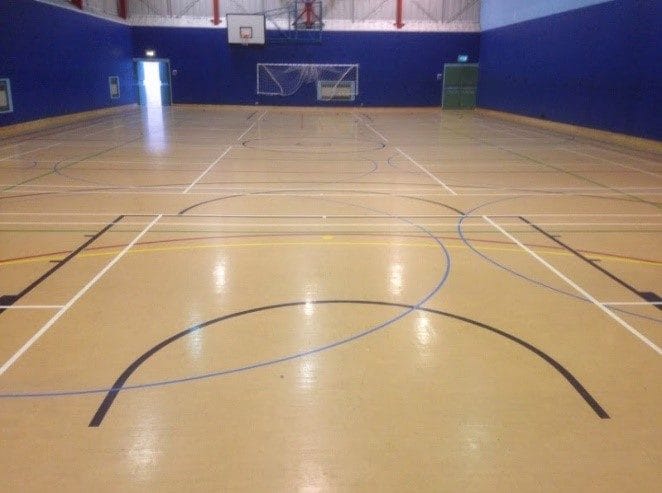Sticky Situations: Uncommon Subfloor Types

F. Ball technical service officer Chris McQuade advises on identifying and working over less familiar subfloor types.
Regular readers of F. Talk will be used to us restating the importance of proper subfloor preparation when it comes to ensuring that flooring installations live up to high expectations and carry on looking their best for years to come. Typically, advice refers to sand/cement screeds, flexible subfloors, such as steel or plywood, or perhaps calcium sulphate screeds.
Sometimes, particularly when working in older buildings, you will come across less common subfloor types. As a result, they are a frequent source of questions for F. Ball’s technical service department. It’s useful to know how to spot and prepare these types of subfloor to avoid floor failure and ensure installations continue looking great. There are a few main ones to look out for.
Asphalt
Mastic asphalt comprises bitumen and aggregate applied to a fibrous quilt, resulting in a loose-lay product at least 10mm thick. It can be installed quickly using a hot charge process, and it cools very rapidly, leaving a seamless and damp proof floor.
If found in a condition that complies with BS8204-5 (screeds, bases and in situ floorings mastic asphalt underlays and wearing surfaces), a smoothing compound can be applied directly over the top, but this should be no more than 6mm thick to avoid subjecting the asphalt to excess stress, which could cause it to crack and result in floor failure. F. Ball’s Stopgap 1200 is ideal for this as it is formulated to minimise the stresses at the bond interface so that it can be applied over old adhesive residues.
Granwood
Traditional Granwood floors were installed from about 1912 using Granwood flooring blocks, which are 174 x 57mm and 10mm thick and made from composite wood fibres, fillers and linseed oil. They are commonly found in old school halls and gymnasiums as they are both very resilient and flexible. Gransprung is Granwood blocks on two 12mm thick resin boards supported by a 12mm resilient rubber pad to provide extra resistance to loading.
While Granwood blocks are inherently moisture resistant, it is not recommended to apply a waterproof surface membrane over them because of their wood fibre/pulp composition, and most installations predate the requirement for a structural damp-proof membrane.
This means that it is often necessary to remove Granwood flooring. However, if sound and a moisture management solution is present, the surface can be abraded to remove polishes and primed prior to the application of a smoothing compound. Gransprung flooring can also be overboarded with plywood prior to the application of a flexible smoothing compound to accommodate movements in the floor.
Magnesite
Usually 10-15mm in thickness and made from magnesium oxychloride cement and fillers, including wood chip, magnesite is a type of screed that is usually red or pink in colour, but it is also coloured yellow or green in some parts of the country. It was widely used as a concrete topping and self-finish floor screed after the Second World War and is commonly found in pre-1965 council properties. The material is conductive, so a test with a Protimeter in WME mode giving high readings is an indicator of magnesite. This must be undertaken in conjunction with a moisture test using a digital hygrometer to discount excess subfloor moisture.
If the screed is unable to ‘breathe’ where excess subfloor moisture is present and floorcoverings are installed then it can cause the magnesite to break down and deteriorate, ultimately leading to floor failure.
It will therefore be necessary to remove the screed on ground floors where the presence of a damp-proof course cannot be confirmed. On upper floors, or where a damp proof course is present, the surface can be skimmed with an appropriate smoothing compound before proceeding with the flooring installation.
Terrazzo
Terrazzo is a composite material, which is poured in place or precast and made up of chips of marble, quartz, granite, glass, or other suitable material with a cement or polymer binder, or a combination of both. It has a polished surface and is nearly always found in commercial areas, such as supermarkets.
Installations can also contain metal feature strips, and there is the chance that rising moisture can escape and cause issues with flooring installations at any joints or edges.
Flooring contractors can avoid the need to remove terrazzo by ensuring that it is sound and well bonded before grinding and cleaning the surface to remove surface treatments to achieve a smooth microtextured finish. If excess subfloor moisture is detected, F. Ball’s Stopgap F77 waterproof surface membrane should be applied to prevent floor failure. Otherwise, contractors may apply Stopgap 1200 directly over the top. If a different smoothing compound is used, it is recommended to prime the surface beforehand with a primer that is designed to promote the application characteristics of subfloor preparation products applied to non-absorbent surfaces, such as Stopgap P141.
Other questions
In each case, flooring contractors can proceed to install new floorcoverings once the subfloor has been suitably prepared.
You can telephone F. Ball’s technical service department throughout the working day for answers to questions you may have about these or any other subfloor types. F. Ball technical representatives are also available for site visits to help identify and advise on the best course of action for preparing any kind of subfloor.